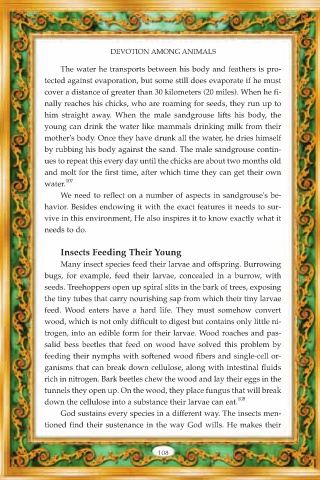Page 110 - Devotion Among Animals Revealing the Work of God
P. 110
DEVOTION AMONG ANIMALS
The water he transports between his body and feathers is pro-
tected against evaporation, but some still does evaporate if he must
cover a distance of greater than 30 kilometers (20 miles). When he fi-
nally reaches his chicks, who are roaming for seeds, they run up to
him straight away. When the male sandgrouse lifts his body, the
young can drink the water like mammals drinking milk from their
mother's body. Once they have drunk all the water, he dries himself
by rubbing his body against the sand. The male sandgrouse contin-
ues to repeat this every day until the chicks are about two months old
and molt for the first time, after which time they can get their own
107
water.
We need to reflect on a number of aspects in sandgrouse's be-
havior. Besides endowing it with the exact features it needs to sur-
vive in this environment, He also inspires it to know exactly what it
needs to do.
Insects Feeding Their Young
Many insect species feed their larvae and offspring. Burrowing
bugs, for example, feed their larvae, concealed in a burrow, with
seeds. Treehoppers open up spiral slits in the bark of trees, exposing
the tiny tubes that carry nourishing sap from which their tiny larvae
feed. Wood eaters have a hard life. They must somehow convert
wood, which is not only difficult to digest but contains only little ni-
trogen, into an edible form for their larvae. Wood roaches and pas-
salid bess beetles that feed on wood have solved this problem by
feeding their nymphs with softened wood fibers and single-cell or-
ganisms that can break down cellulose, along with intestinal fluids
rich in nitrogen. Bark beetles chew the wood and lay their eggs in the
tunnels they open up. On the wood, they place fungus that will break
108
down the cellulose into a substance their larvae can eat.
God sustains every species in a different way. The insects men-
tioned find their sustenance in the way God wills. He makes their
108

